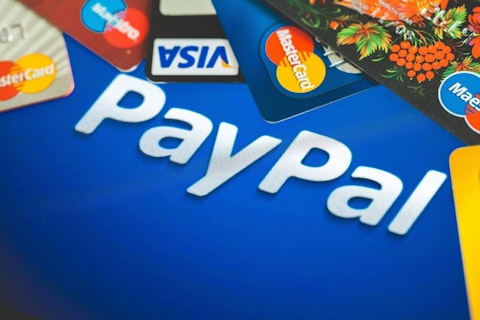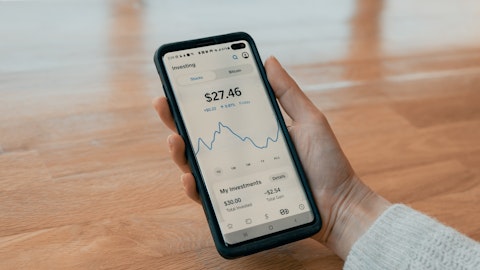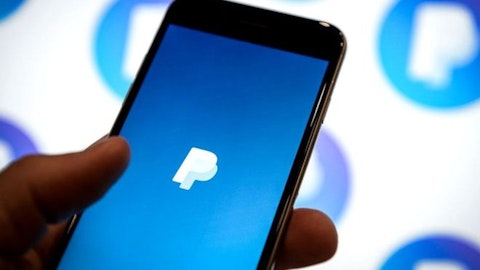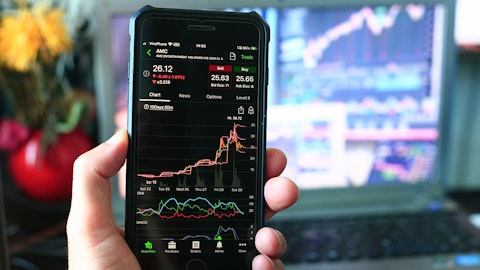PayPal Holdings, Inc. (NASDAQ:PYPL) Q2 2023 Earnings Call Transcript August 2, 2023
PayPal Holdings, Inc. misses on earnings expectations. Reported EPS is $0.65 EPS, expectations were $1.16.
Operator: Good afternoon. My name is Sarah, and I will be your conference operator today. At this time, I would like to welcome everyone to PayPal Holdings’ Earnings Conference Call for the Second Quarter 2023. All lines have been placed on mute to prevent any background noise. After the speakers’ remarks, there will be a question-and-answer session. [Operator Instructions] I would now like to introduce your host for today’s call, Ms. Gabrielle Rabinovitch, Senior Vice President and Acting CFO. Please go ahead.
Gabrielle Rabinovitch: Thank you, Sarah. Good afternoon, and thank you for joining us. Welcome to PayPal’s earnings conference call for the second quarter of 2023. Joining me today on the call is Dan Schulman, our President and CEO. We’re providing a slide presentation to accompany our commentary. This conference call is also being webcast, and both the presentation and call are available on our Investor Relations website. In discussing our company’s performance, we will refer to some non-GAAP measures. You can find the reconciliation of these non-GAAP measures to the most directly comparable GAAP measures in the presentation accompanying this conference call. We will make forward-looking statements that are based on our current expectations, forecasts and assumptions and involve risks and uncertainties.

www.BillionPhotos.com / Shutterstock.com
These statements include, without limitation, our guidance for the third quarter and full year 2023 are planning assumptions for 2023. Our comments related to anticipated foreign exchange rates, operating margin impact from our sale of loans to KKR and share repurchase activity. Our actual results may differ materially from these statements. You can find more information about risks, uncertainties and other factors that could affect our results in our most recent annual report on Form 10-K and quarterly report on Form 10-Q filed with the SEC and available on our Investor Relations website. You should not place undue reliance on any forward-looking statements. All information in this presentation is as of today’s date, August 2, 2023. We expressly disclaim any obligation to update this information.
With that, let me turn the call over to Dan.
Daniel Schulman: Thanks, Gabe, and thanks, everyone, for joining us on today’s call. I’m proud of the PayPal team as we delivered another solid quarter. Revenues came in above the top end of our guidance, and non-GAAP EPS grew 24% to $1.16 in line with the midpoint of our guide. And we are reiterating our guidance for non-GAAP EPS and operating margin expansion for the full year. Encouragingly, e-commerce growth appears to have stabilized in the mid-single digits, substantially above our estimates when we entered 2023. Our branded checkout volumes grew roughly in line with the industry in Q2 and accelerated to nearly 6.5% growth in the month of June, and in July, our branded checkout volume growth accelerated again to over 8%, our highest monthly growth rate since the end of the pandemic.
We expect branded checkout volumes will strengthen throughout the back half of the year, supported by traction from our key strategic initiatives. Of course, we still face a fluid global macroeconomic environment. However, it is quite encouraging to see core inflation rates continue to come down. As inflation cools, we would expect to see discretionary spending rise, which we believe will support and possibly accelerate the overall growth of e-commerce spending. And as the market leader in digital payments, any uptick in e-commerce will accelerate our growth. Revenues in Q2 grew by 8% on a currency-neutral basis to approximately $7.3 billion. It’s instructive to note that we are lapping certain items that provided an outsized benefit to us in Q2 and Q3 last year.
Consequently, those items pressure our revenue growth rate by approximately 1.25% in each of those quarters this year. Excluding these items, our growth in Q2 would have been between 9% and 10%. As we mentioned last quarter, we expect our revenue growth in the second half of the year to be roughly the same as and given recent trends, maybe a bit better than the first half. We expect Q3 revenues to grow approximately 8% on a currency-neutral basis. I would highlight that July was a very strong start to the quarter with currency-neutral revenue growth of 9% and TPV growth accelerating into the low teens. And for the year, we anticipate our revenue growth to be between 9% and 10% on a currency-neutral basis. We continue to exercise good discipline in managing operating expenses.
For the quarter, non-GAAP nontransaction-related expenses fell 11% year-over-year. As a result, our non-GAAP operating margin was 21.4%, up approximately 230 basis points from a year ago. We expect to increase our non-GAAP operating margin for the full year by at least 100 basis points. As we look ahead to the rest of 2023 and into 2024, we expect to drive meaningful productivity improvements. Our initial experiences with AI and continuing advances in our processes, infrastructure and product quality, enable us to see a future where we do things better, faster and cheaper. These overall cost savings come even as we significantly invest against our three strategic priorities. We know exactly what we need to do as we look towards 2024. And as you can see in our results, we are beginning to see the fruits of our labor.
We understand that over the medium to long term, we need to deliver growth in our transaction margin dollars to ensure we sustainably grow our earnings. And we are beginning to see clear signs that our initiatives will yield notable traction against that objective over the next several quarters. As I mentioned, we expect our top line to accelerate to low double-digit growth by Q4. We expect transaction margin dollars to increase while our operating expenses continue to create significant leverage. That in connection with our share buybacks enables us to target low to mid-teens EPS growth for the remainder of 2023, even as we begin to lap the increases we enjoyed on our interest income. I’d like to now turn to our three strategic priorities in which we are investing our resources and energy, branded checkout, our PSC merchant solutions and our digital wallets.
As I’ve mentioned in the past, all three of these are critical and interrelated. They are essential for us to increase our share of the e-commerce market as well as accelerate our margin dollar growth. As we discussed in our June investor meeting, we are meaningfully accelerating new product innovations into the market, scaling our A/B testing and significantly improving our time to market. We are now consistently delivering against our road map on schedule. This is the result of significant investments in our platform infrastructure and tools and enhanced set of measurements and performance indicators, hiring new talent and early successes using AI in our software development process. We continue to ramp our test velocity with more than 300 experiments launched across our product experience in the first half of the year.
Every successful test leads to incremental customer benefits and the cumulative effect of those changes leads to noticeable improvements in our key metrics, including the gains we are seeing in branded checkout growth. For instance, our buy now, pay later traction has meaningfully accelerated with the introduction of preapproved amounts to our consumers. Our work in onboarding and onboarding new experiences has driven new monthly cohorts with higher engagement and lifetime value. In this month, we are expanding the rollout of Paske [ph] in the U.S. and Europe, which will greatly simplify the branded checkout log-in experience and drive improved authorization rates that will further extend our lead over our competitors. Our goal is to continually close the gap in our log-in and checkout experiences every quarter and to be equal to or better than any competitor within the next year.
We simultaneously aim to drive differentiated wallet experiences across both PayPal and Venmo. We believe that only those companies with unique and scaled data sets, we’ll be able to fully utilize the power of AI to drive actionable insights and differentiated value propositions for their customers. We are already experimenting internally with an AI-driven PayPal assistant. We envision that a version of this will be part of our consumer app, and we plan to introduce it later this year. We continue to see impressive traction in our PSP business with our growth rates nearly 30% on a currency-neutral basis. Many of the largest tech companies in the world are now either using our Braintree capabilities or are in deep strategic negotiations with us to do so.
We are in the process of rolling out high-margin, value-added services, expanding internationally and making noticeable progress with in-person payments. And we continue to receive exceptional interest in our next-generation checkout solution, which will leverage the scale of our network Vault, our deep understanding of our two-sided network and the development of proprietary AI models. I couldn’t be more pleased with the initial rollout of PayPal Complete payments. Our PSP merchant solution for channel partners and the SMB market. We are seeing tremendous interest in the platform with a substantial pipeline of completed sales and a backlog of deals that continues to grow. Importantly, our major channel partners are enthusiastic about its capabilities.
We have already implemented PPCP, with leading channel partners like Adobe, LightSpeed, Recurly, Shift4, Shopify, Stacks Payments, UltraCare, Wix and WooCommerce with more than 25 additional channel partners scheduled to be live by the end of the year. This not only demonstrates the strength of our platform capabilities but will also enable a meaningful number of SMB merchants to access our latest checkout experiences. There is a remarkable sense of energy, excitement and enthusiasm among our leadership teams as we see clear and distinct signs of reinvigorated success in the market. We are now able to take advantage of many of the investments we have made over the past years to deliver a best-in-class experience for our customers, leveraging a modern infrastructure and our scale in the age of AI.
We have successfully recruited a large number of external talent to complement our internal teams in both AI and machine learning as well as throughout our product, engineering and technology groups in order to build upon our success and maximize our opportunity. I’d like to end my remarks talking about our CEO succession plan. We are in the very final stages of the process. with several outstanding candidates, all of whom are highly qualified and excited to lead PayPal as we go into our next chapter of growth. I’m eager to welcome PayPal’s next CEO to work with them on a seamless onboarding and to support them in the amazing PayPal team as I transition to my role on the Board. As you can hopefully tell, we have a lot of energy and confidence that we are on the right path with good momentum.
Many of the headwinds we faced are now turning into tailwinds. We are executing with a high degree of excellence. We have a firm handle on our business model and can point to numerous successes already making a real difference in the market, which will only continue to compound over time. PayPal is in an increasingly strong position, and we are poised to deliver for our customers and our shareholders. Thank you. And with that, let me turn the call over to Gab.
Gabrielle Rabinovitch: Thanks, Dan. I’d like to start by thanking the entire PayPal team for their continued commitment to serving our customers and executing our priorities. PayPal delivered another solid quarter in a dynamic environment. We’re reporting revenue at the high end of our guidance range and earnings per share consistent with our expectations. Our results are tracking with the guidance we gave for the full year and reflect steady progress against our long-term growth aspirations. We continue to invest in our key initiatives, while demonstrating discipline in delivering on our operating expense commitments. In June, we were delighted to share more about our long-term strategic plan and product road maps at our investment community meeting.
Importantly, the product launches we discussed are on track, and we continue to gain conviction in our ability to accelerate our branded checkout volumes and drive greater profitability across our PSP services. During the quarter, we were pleased to announce a multiyear agreement to sell both our existing European Buy now Pay Later receivables as well as future originations to KKR. During my remarks, I will discuss the impact of this externalization on our financial results. We have also included additional details in our investor update presentation. Before discussing our outlook for the remainder of the year, I’d like to highlight our second quarter performance. As Dan mentioned, revenue increased 8% on a currency-neutral basis and 7% at spot to $7.3 billion.
Transaction revenue grew 5% to $6.6 billion, driven primarily by Braintree and PayPal branded checkout. Headwinds to growth in the quarter included the lapping of $75 million in contractual compensation from merchants last year, which was de minimis this year, $72 million less in hedge gains relative to Q2 last year and the impact from migrating and consolidating legacy PayPal payment services. Other value-added services revenue grew 37% to $731 million. This performance was predominantly due to increased interest income on customer store balances and to a lesser extent, revenue growth from consumer credit products. In the second quarter, U.S. revenue grew 9% and international revenue increased 5%. On a currency-neutral basis, international revenue increased 7%, accelerating sequentially and year-over-year.
Transaction take rate declined 11 basis points to 1.74%. Approximately two thirds of this decline was driven by a decline in foreign exchange fees, in part driven by lower currency volatility, a decline in gains from foreign currency hedges, which are recorded as international transaction revenue and the headwind from lapping elevated contractual assessments from merchants last year. While merchant mix continued to pressure our branded checkout take rate, the second quarter was an improvement from Q1. Our total take rate declined 6 basis points to 1.94%, affected by the same factors as transaction take rate. Transaction expense as a rate of TPV came in at 94 basis points, 4 basis points higher than Q2 last year. This increase was primarily driven by growth in Braintree volumes, partially offset by rate benefits in core PayPal and Venmo.
Overall, transaction expense dollars grew 16%. Transaction loss as a rate of TPV was 8 basis points for the quarter, a 3.6 basis point improvement versus last year. Transaction loss dollars declined 25%. The decrease this year was primarily due to an atypical merchandise solvency last year, which drove a sizable loss in the second quarter with no comparable exposure this year. Our ongoing risk mitigation activities and mix of volumes also contributed to this performance. Credit losses were $112 million or 3 basis points of the rate of TPV. On a dollar basis, credit losses increased 65%. Provisions in the quarter were driven by a build of $146 million, partially offset by a $33 million reserve release from the reclassification of our European Buy now Pay Later portfolio to held for sale from held for investment.
The operating income benefit from this release of reserves was entirely offset by the fair value discount on the portfolio classified as held for sale. The increased provisioning resulted from increased expected losses in our PayPal business loans portfolio as well as growth in our U.S. Paylater portfolio. Like the broader industry, we’re seeing a normalization of our credit portfolio to pre – COVID delinquency levels across our consumer and PayPal working capital portfolio. That said, we have seen some deterioration in our business loans portfolio. This portfolio represents less than 15% of our overall net credit receivables. And as we discussed last quarter, we have taken remedial actions to address this performance. We’ve tightened originations and have already seen improvement in new cohorts.
We’ll be managing the book with similar rigor as we move through the remainder of the year. As a result of designating $1.9 billion in pay later receivables to assets held for sale, we ended Q2 with $5.5 billion in net credit receivables, a 3.5% decline year-over-year and a 26% decline sequentially. The decline in receivables due to held for sale accounting also contributed to an increase in our reserve coverage ratio. This ratio increased to 10% from 7.8% in Q1. In the aggregate, volume-based expenses increased 13% in Q2 relative to an increase of 30% in the second quarter of 2022. Transaction margin dollars grew 1% to $3.3 billion, and transaction margin was 45.9%. While our transaction margin declined in the quarter, the rate of decline slowed considerably from both Q1 and the second quarter of last year, and we’re executing on our strategy to grow transaction margin dollars.
We’re encouraged by the progress we’re making against our longer-term initiatives that will support improved transaction margin performance over time. Q2 marked the third quarter in a row that we’ve delivered meaningful expansion in our operating margin on both a GAAP and non-GAAP basis. Ongoing discipline in managing our cost structure allowed us to more than offset transaction margin compression with operating expense leverage. On a non-GAAP basis, nontransaction-related operating expenses declined 11%, with reductions across each of our principal operating expense categories contributing significant leverage. Strong expense performance resulted in 20% growth in non-GAAP operating income to $1.6 billion. This is the highest growth in operating income that we’ve delivered in more than 2 years.
Non-GAAP operating margin expanded 228 basis points to 21.4%, which was slightly below the guidance we gave for the quarter. This is principally attributable to our credit portfolio, where we earned less revenue than expected and increased loss provisions. For the second quarter, non-GAAP EPS increased 24% to $1.16, which was the midpoint of our guidance range. We ended the quarter with cash, cash equivalents and investments of $14.4 billion. The net cash outflows for originations of loans held for sale reduced cash flows from operations by $1.2 billion in the quarter, resulting in free cash flow for the quarter of negative $350 million. Later this year, when the sale of the European BNPL back book closes, the proceeds will be recognized in cash flows from operations and offset this decline.
So while the timing of accounting treatment will affect the quarterly profile of our free cash flow, there is no change to our outlook for the year, and we continue to expect to generate approximately $5 billion in free cash flow. In the quarter, we completed $1.5 million in share repurchases. For the full year, we now expect to allocate approximately $5 billion to our buyback program. Our recently announced credit externalization will help optimize our balance sheet and improve our capital efficiency. Given our desire to return capital to shareholders and the confidence we have in our business, we’ve taken a more aggressive approach to share repurchases. Since the end of 2021, our diluted share count has declined 6%. I would now like to discuss our outlook for the remainder of 2023.
As Dan shared, based on our results from the first half of the year, we’re reaffirming our guidance for the year for non-GAAP operating margin expansion and earnings per share. In the aggregate, for the first and second quarters of 2023, we’ve delivered revenue growth of approximately 9% on a currency-neutral basis. We expect revenue growth in the back half of the year to be in line with this performance, if not slightly ahead, given the momentum we’re seeing in the business. In addition, we’re on track to meet our expense guidance for the year and are committed to delivering at least 100 basis points of non-GAAP operating margin improvement. We also continue to expect to deliver non-GAAP earnings per share of approximately $4.95, representing 20% growth from 2022.
We’re reiterating our full year guidance while absorbing incremental pressure from our credit portfolio, given strengthening business performance driven by checkout initiatives and our ongoing realization of productivity gains. For the third quarter, we expect revenue to grow approximately 8% on both a spot and currency-neutral basis to approximately $7.4 billion at current spot rates. In addition, we expect non-GAAP earnings per share to be in the range of $1.22 to $1.24, representing growth of approximately 13.5% at the midpoint of the range. In summary, we’re proud of our solid operating results this quarter. PayPal’s unique competitive advantages, including our portfolio of differentiated assets and our global scale and ubiquity continue to drive us forward.
We’re committed to investing in our core strengths and building PayPal for the future, and we’re guided by our relentless focus on creating the best possible experiences for our customers. Our revenue momentum and customer engagement trends position us well to achieve our growth objectives this year and beyond. Given the uncertainties in the macroeconomic environment, we remain focused on managing the things we can control and allocating capital with discipline to ensure we optimize for long-term value creation and resiliency. And with that, Dan and I are happy to take your questions. Sarah, please go ahead.
See also 10 Stocks That Will Go Up 1000 Percent and Top 20 Smart Cities in the World.
Q&A Session
Follow Paypal Holdings Inc. (NASDAQ:PYPL)
Follow Paypal Holdings Inc. (NASDAQ:PYPL)
Operator: Thank you. [Operator Instructions] Your first question comes from the line of . Your line is open.
Tien-Tsin Huang: Hey, thanks a lot. I want to ask a question on e-commerce Health. And Dan, I know you talked about it upfront. We’re just getting a lot of questions on the e-commerce industry in general. So you mentioned inflation easing should help. I’m curious about other trends like shift from services to goods like our economists are talking about, which I think would also be a tailwind for you versus an previously. Is this something you’re seeing? Or maybe is that changing how you’re thinking about the second half versus a quarter ago? It seems like there’s some room for upsetting your outlook here given the exit growth rate and what you talked about for July? Thanks.
Daniel Schulman:
Tien-Tsin: E-commerce is definitely one of those. We see e-commerce growth accelerating. We think it is at least in the mid-single digits right now. That’s substantially above what we thought when we entered the year where we thought it might be flat year-over-year. And I would say I’ve got a slight bias that, that will continue to accelerate. You’ve got a range out there from low of zero to high 10%. We think it’s probably right in the middle of that, and we think it is being driven by a shift from travel and services into goods and to fashion, where coming into retail pieces of that. And clearly, as inflation cools, we would expect to see more discretionary spend rebound, and that will help drive e-commerce. So one of the headwinds we faced was e-commerce growth slowing.
Now it’s accelerating again, and that clearly will be meaningful for us. We’re also seeing improvements, as Gabi mentioned, in cross-border. That’s beginning to accelerate again. That’s obviously a very meaningful thing for us because, one, our value proposition is perfect for cross-border. It’s consumers buying from merchants that they don’t really know, but they trust PayPal and make sure that, that payment will be protected for them. It’s obviously extremely high-margin business for us, and that seems to be accelerating nicely right now. PPCP, which was a really important introduction for us for numerous reasons, could not have a better reception in the market. We’ve got tremendous momentum there. Braintree continues to go from strength to strength, and we’re seeing a lot of our value-added services now start to take hold.
I can talk about some of that later in the call. Somebody wants to ask about that. And obviously, branded checkout is accelerating. That 8% is the highest we’ve seen since the end of the pandemic. And — we continue to expect to see that strengthen as we go through the year as many of our initiatives are really taking hold in the last quarter. We’ve got another 200-plus experiments that are going to happen in Q3. And so that’s all adding to momentum. And I guess at the end of the day, what that’s adding up to when we look at our Net Promoter Score, we’re now at a 7-year high in that. And so there’s clearly a lot of momentum in the business right now, and we just want to double down on that. So we do obviously feel a lot better today than we did 90 days ago.
But I think that’s just going to continue when you ask that same question a quarter from now.
Operator: Your next question comes from the line of Darrin Peller with Wolfe Research. Your line is open.
Darrin Peller: Hey, Thanks, guys. Revenue growth was obviously sound, but we still saw transaction profit dollars a little less pronounced versus revenue. I think it actually may have decreased a bit year-over-year. And so Gabriel, I know you talked about some one-time grow-overs and hedging differences. And I’m sure the mix between branded and branded continues to have an impact given the growth of Greentree. But if you could just help us understand the moving parts in the quarter and the trends in the second half as far as gross profit or transaction profit growth goes, that would be great.
Gabrielle Rabinovitch: You bet. You bet, For the quarter, transaction margin dollars grew 1%, which is essentially in line with Q1. That said, when we look at the underlying performance of our business, we’re very encouraged by the stronger results we’re seeing. In my prepared remarks, I called out several items that created headwinds to growth in the quarter due to lapping. In addition, we actually had some benefits that we saw in the quarter as well from the release of reserves from held for sale reclassification as well as from lapping that large merchant exposure last year. And so when we adjust for all these items, both the benefits and the drag on a more normalized basis, we actually see transaction margin dollars in the quarter growing several points faster than the reported 1%.





